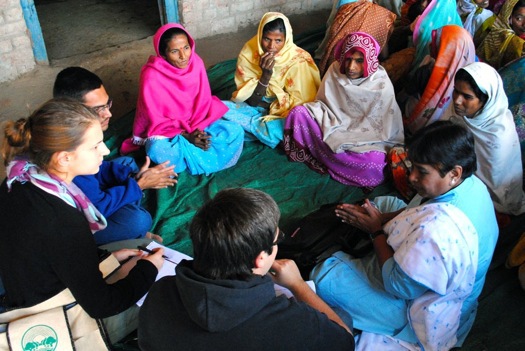
October 10, 2011
Expert Thinking About Global Aid

University of Cincinnati students meeting with women near Dahod, Gujurat, India, 2010.
This fall, I’m headed back to school to teach an honors course at the University of Cincinnati. The course combines students from several disciplines in a study of rural development in India and culminates in a three-week trip to the subcontinent for a work/study tour. During the quarter, we study several development economists — writers who provide a background for understanding rural development initiatives and who give the students crucial context for their work in India. I’ve come to know these scholars in my own experience with Design Impact as I try to make sense of the “right” way to do development work from a design angle. Their writings provide insight for anyone trying to produce “good” design and I hope the quick synopsis below illustrates that point.
Jeffery Sachs and His Detractors
Outside of Steven Levitt or Alan Greenspan, Sachs is probably the most widely known economist in the world. He’s so famous Bono wrote the introduction to his book The End of Poverty. In this book Sachs argues that the world as a whole is growing economically, but that poor countries are in a poverty trap — they are missing the essential components to jump onto the ladder of development. His solution, captured in the UN Millennium Goals, is to infuse the development system with a lot more money and focus it into proven, state-level interventions in education, healthcare, infrastructure and market development. His argument is at the center of the pro-aid camp.
Sounds great, right? Well, it’s hard to be on top, and Sachs has plenty of detractors, the loudest of whom is probably William Easterly. In his book The White Man’s Burden, Easterly takes aim at Sachs’s top-down, supply-side argument, saying that high-level planning and aid efforts have overspent and underdelivered for the past 40 years. He argues that aid does not work and that development initiatives need to take a demand-side approach. This means that the interventions must look at users as consumers, identify needs and seek out opportunities.
The Bed Net Breakdown
The difference between these two camps is best illustrated by the “bed net controversy.” Bed nets are thin, insecticide-treated mesh nets that are draped over beds at night. In malaria-prone areas of the world, widespread usage of nets is proven to reduce the instance of the disease. From a “pro-aid” point of view, reducing malaria means having bed nets in the hands of as many people as possible, and this often means giving them away. This was the established mode of distributing bed nets in Africa until around 2005, when a study compared the results of a free bed net program with those of a program that sold the bed nets for a subsidized price of 50 cents (they actually cost about $8). This study showed that when bed nets were sold, not given away, more people continued to use them. The “anti-aid” camp was ecstatic, and used this information to claim that by giving bed nets away (charity), you undermine the market and devalue the solution. This sounds like a clear win for market-based solutions, but the story does not end there.
In 2010, an organization that had been distributing bed nets for free wanted to see if their program was still worth pursuing. Using a randomized control test they were able to prove that — in their region — bed nets were used with the same frequency whether they were sold or donated. While the researchers found that the same number of households continued usage, they also discovered that even a small initial cost was enough to greatly reduce the number of people who bought, and thus used, the bed nets in the first place. This study directly refuted the earlier study and boosted the pro-aid camp. So, in the end, who is right — the pro- or anti-aid groups?
The answer may be neither. In their trend-breaking tome, Poor Economics, Harvard professors Abhijit Vinayak Banerjee and Esther Duflo explain that there is no right way to approach these issues, except for developing a deep, on-the-ground understanding of impoverished users. In addition, Banerjee and Duflo stress that our intuition in these situations is often misleading, and that we need to look at development as a scientist may look at an experiment. The need to test the results of interventions and analyze why the effort did or did not succeed is essential for understanding and developing solutions that actually work.
Design for Development
Designers are often paid to stimulate demand, and in “design for development” circles, the discussion is heartily in support of anti-aid, pro-market solutions. I have been to too many conferences where the phrase, “Teach a man to fish…” is bandied about like a holy mantra. But it is important for designers to listen to the work of economists like Banerjee and Duflo and recognize that while there are no pre-fab solutions for successful development projects, there are several ways that design can add value in this new context.
First, designers are adept at understanding users’ needs. By focusing on our proven record of accomplishment in this territory, and adjusting our techniques to develop meaningful relationships with users, design could add significant new perspectives to traditional development approaches. This may seem like common sense, but developing intimate ongoing relationships with users is the best way to be sure that your product or service is useful and desired and that it has the intended impact.
Additionally, understanding not only what kind of demand can be created through design, but also what the impact will be through usage is essential for making good intervention decisions. Designers are relatively new to the world of development and social causes; it would behoove us to use caution and approach problems with the mindset of a scientist. This is not to say that we should abandon our actionable strengths of turning concepts into meaningful, testable prototypes, but that partnering, or developing expertise in measuring the impact and outcomes of our projects, may be equally important.
As designers, we are definitely not economists and most of us don’t have Ph.Ds from Harvard or sophisticated algorithms for understanding conceptual impact. But as design matures into a serious field of study, it must develop a deeply critical point of view that funds and celebrates projects and individuals who take the time to develop relationships and look intently at our true effect on the world. This holds not only for design in development, but for all design. Only when we understand our true impact can we be sure that we are practicing good design.
Observed
View all
Observed
By Ramsey Ford
Recent Posts
Runway modeler: Airport architect Sameedha Mahajan on sending ever-more people skyward The New Era of Design Leadership with Tony Bynum Head in the boughs: ‘Designed Forests’ author Dan Handel on the interspecies influences that shape our thickety relationship with nature A Mastercard for Pigs? How Digital Infrastructure is Transforming Farming and Fighting Poverty




